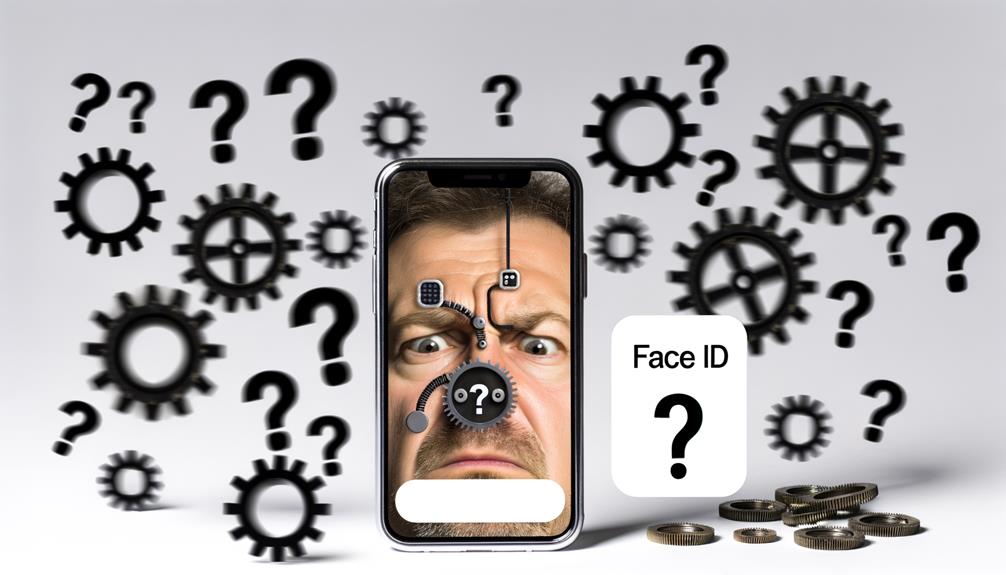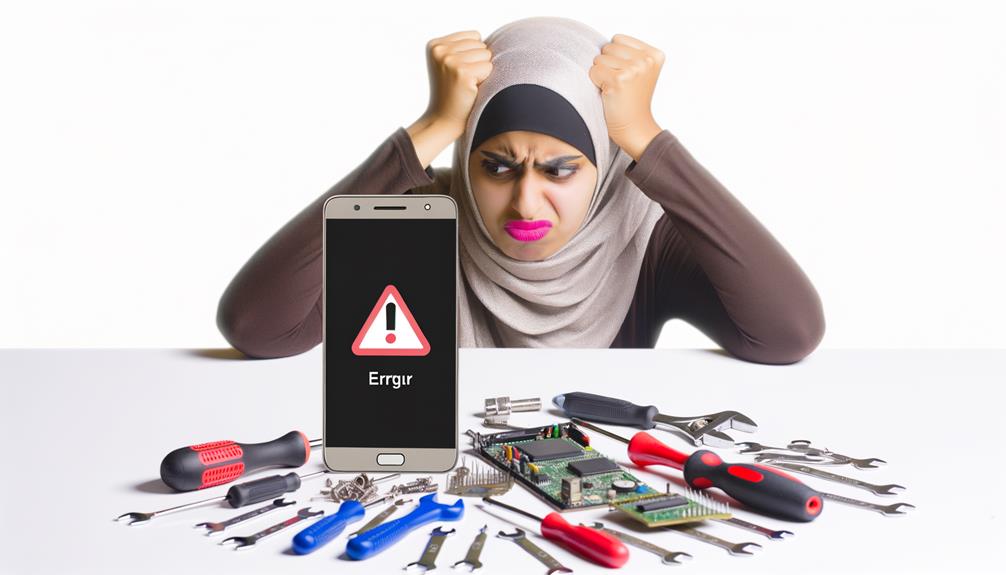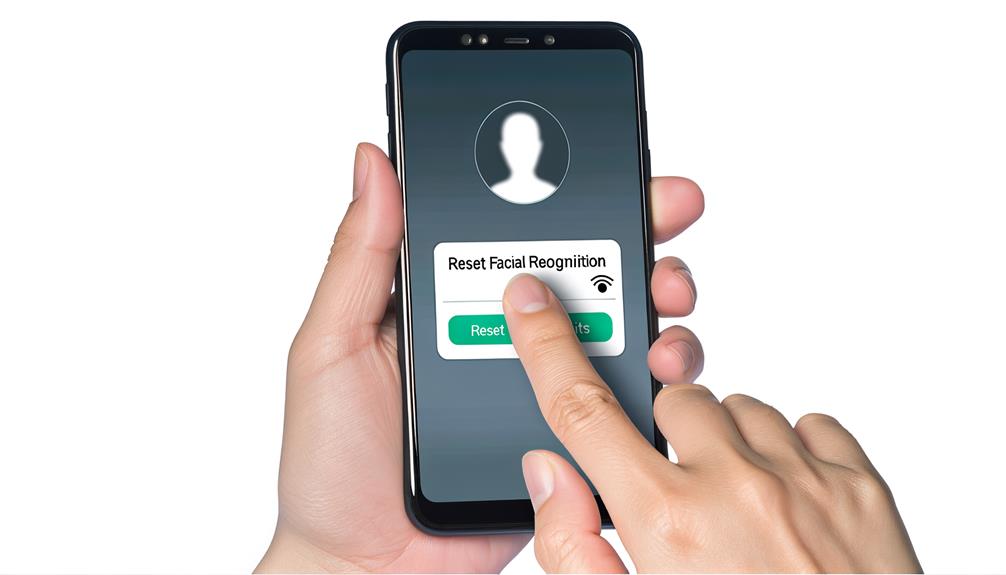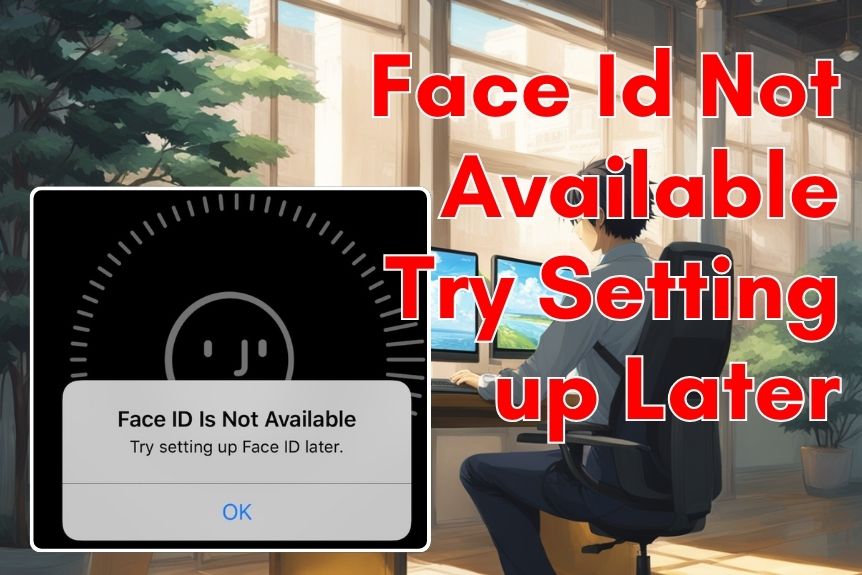If you’re facing the ‘Face ID not available, try setting up later’ issue, it could be due to recent software updates, hardware problems, or device setting changes. Try resolving it by resetting your Face ID or cleaning your camera sensor. Make sure your iPhone model supports Face ID and there’s clear visibility for the TrueDepth camera. If your Face ID is still puzzling you, it might be time to reach out to Apple Support for a helping hand. Stick around, and you may find ways to dodge these hurdles in the future.
Understanding the Face ID Issue

While it’s usually a seamless experience, you might find yourself facing the ‘Face ID not available‘ message, a problem that can stem from software updates, hardware issues, or even changes in your device settings. You’ll typically encounter this issue after specific events, such as after installing a new update or tweaking your device settings.
Visibility issues also play a role in this. If your TrueDepth camera sensor can’t get a clear view of your face, due to poor lighting or an unfavorable camera angle, your Face ID might fail to recognize you. Another potential culprit could be a dirty TrueDepth camera sensor. Small particles of dust or smudges can interfere with the camera’s ability to scan your face accurately.
Trying to resolve this issue isn’t rocket science. Resetting your Face ID settings or cleaning your TrueDepth camera sensor can often do the trick. But, if the problem persists, don’t hesitate to reach out to Apple Support. They’re well equipped to assist you in troubleshooting and resolving this ‘Face ID not available’ issue. So, it’s imperative to understand the potential causes to navigate towards the right solutions.
Necessary Device Checks
Before delving into troubleshooting, it’s imperative to perform some necessary device checks to ensure your iPhone’s Face ID functionality is at its peak. Start by confirming that your iPhone model supports Face ID. Not all iPhone models are equipped with this feature, hence the importance to verify its availability.
Next, validate that nothing obstructs the TrueDepth camera on your iPhone. Dirt, coverings, or even certain screen protectors might disrupt the Face ID functionality.
Also, make sure that your iOS is up-to-date. Apple frequently releases software updates to improve features and fix bugs. An outdated iOS could be the reason your Face ID is not working.
Lastly, it’s vital to check that the Face ID settings are correctly configured. Go to Settings > Face ID & Passcode > Set up Face ID and follow the instructions. If Face ID is still not available, contact Apple Support for further assistance.
Here’s a quick reference table for you:
| Check Point | Relevant Settings | Action |
|---|---|---|
| Device Compatibility | Model Specifications | Confirm Face ID availability |
| TrueDepth Camera | Physical Check | Ensure no obstruction |
| iOS Update | Settings > General > Software Update | Check for updates |
| Face ID Settings | Settings > Face ID & Passcode > Set up Face ID | Confirm correct configuration |
Possible Face ID Fixes

If you’re encountering issues with Face ID, don’t worry; you can follow some tech-savvy steps to rectify the situation.
Resetting Face ID settings, updating your iOS software, and ensuring ideal lighting conditions during setup are some potential fixes.
We’ll guide you through each of these solutions and their implementation in the following sections.
Resetting Face ID Settings
Running into issues with Face ID not being available? Resetting your Face ID settings might be the quick fix you’re looking for. If you’re grappling with Face ID unavailability, here’s how to reset and reconfigure it for better recognition, without erasing any data.
Firstly, access ‘Settings’ on your device, then tap ‘Face ID & Passcode’. Here, you can reset your Face ID.
| Steps | On Screen Instructions |
|---|---|
| 1. Access Settings | Scroll down and tap on ‘Face ID & Passcode’ |
| 2. Reset Face ID | Follow the prompts to reset and start the process of reconfiguration |
| 3. Reconfigure Face ID | Follow the on-screen instructions to set up your Face ID again |
This simple reset could be key in fixing your Face ID issues, so give it a try.
Updating Ios Software
To troubleshoot persistent Face ID issues, it’s worth confirming that your device’s iOS software is up-to-date. Regular updates often resolve Face ID unavailability by fixing bugs and enhancing system stability. They also address security vulnerabilities, which can impact Face ID reliability.
New iOS updates could include specific optimizations for Face ID, improving its functionality. Thus, to fix Face ID, updating your iOS is a significant method. Additionally, installing the latest iOS version ensures compatibility with Face ID features. It may address underlying software conflicts, thereby improving Face ID troubleshooting.
Keeping your device updated is an advisable step to tackle the ‘Face ID not available’ error. Overall, regular iOS updates play a key role in rectifying Face ID issues, enhancing its usability and reliability.
Ensuring Optimal Lighting Conditions
In optimizing Face ID’s functionality, it’s essential that you’re in a well-lit environment, as this technology performs best under natural light conditions. Avoid shadows or bright light, which could compromise Face ID accuracy. Position yourself to minimize glare and reflections that might interfere with recognition.
Artificial lighting can impact Face ID’s performance, so if you’re indoors, adjust your lighting settings. Consistency is key. Ensuring a consistent lighting environment helps maintain Face ID’s reliability.
Consider the following table:
| Environment | Lighting | Face ID Performance |
|---|---|---|
| Well-lit | Natural | Excellent |
| Shadowy | Natural | Poor |
| Bright | Artificial | Variable |
| Consistent | Any | Reliable |
| Glare/Reflection | Any | Compromised |
Resetting and Reconfiguring Face ID

You’ve encountered a roadblock with your Face ID, but don’t worry, resetting and reconfiguring can often be the solution.
Let’s go through the steps of resetting Face ID, wiping the slate clean, and then properly configuring it again.
If done correctly, you’ll be back to a seamless accessing experience in no time.
Understanding Face ID Reset
Traversing through the process of resetting your Face ID, it’s crucial to understand that this involves erasing the existing facial recognition data from your device. Fundamentally, you’re granting your iPhone or iPad a clean slate to recalibrate the recognition of your unique facial features.
Four key points guide the understanding of a Face ID reset:
- The reset eradicates stored facial recognition data.
- Post-reset, you’ll need to set up Face ID anew, going through the facial recognition process again.
- This re-setup guarantees Face ID is accurately calibrated to recognize your face.
- Resetting is a practical troubleshooting step if Face ID becomes unavailable or is having issues with recognition.
Understanding these aspects can make the Face ID reset process less intimidating and more effective.
Steps for Resetting FaceID
After gaining a solid grasp on the rationale behind a Face ID reset, let’s guide you through the actual steps of resetting and reconfiguring your Face ID, a straightforward yet potent solution for resolving any Face ID availability issues on your device. Start by accessing your Settings, then tap on Face ID & Passcode, and select ‘Reset Face ID‘. This action initiates the reset process, helping when Face ID isn’t available or not working properly.
Following the reset, the system will prompt you to set up Face ID again. Remember to have a clear, unobstructed view of your face, sans any face mask, for the infrared technology to accurately recognize your features. This resetting maneuver can effectively troubleshoot Face ID‘s availability hiccups.
Reconfiguring Face ID Properly
Often, when you’re facing challenges with Face ID, it’s beneficial to reset and re-establish it correctly to guarantee optimum performance. Here’s your tech-savvy guide for resetting and reconfiguring Face ID on your iPhone.
- Go to your iPhone’s Settings. Tap on ‘Face ID & Passcode’ and choose ‘Reset Face ID’.
- After resetting Face ID, set it up again by following the on-screen instructions. Make sure to position your face correctly to guarantee the TrueDepth camera can accurately scan it.
- Remember to clean the TrueDepth camera sensor before you begin setting up your Face ID. Any blockage could disrupt the process.
- After reconfiguring, you can now access your iPhone using Face ID, even while wearing a mask.
When to Contact Apple Support

If you’ve exhausted all troubleshooting steps and Face ID still isn’t available, it’s time to consider reaching out to Apple Support. They can assist with unresolved problems and provide advanced solutions. Despite your best efforts, some Face ID issues may persist due to hardware issues. Remember, it’s always okay to seek help.
In such situations, contacting Apple Support can be the key to resolving these issues. They have the professional assistance to deal with any persistent Face ID unavailability issues that you can’t resolve. Knowing when to step back and let the professionals handle it is crucial.
Here is a simple table to guide you on when to reach Apple Support:
| Face ID Status | Troubleshooting Attempted | Contact Apple Support? |
|---|---|---|
| Unavailable | Yes, multiple times | Yes |
| Unavailable | No | Try troubleshooting first |
| Available but not working | Yes, multiple times | Yes |
| Available but not working | No | Try troubleshooting first |
| Working properly | N/A | No need |
Don’t hesitate to contact Apple Support if you’re facing unresolved Face ID problems. They’re there to provide assistance and make sure your device functions as it should.
Alternative Unlocking Methods
When you’re dealing with a challenge with persistent Face ID issues, it’s worth turning to alternative access methods for your iPhone. Particularly, when Face ID unavailability becomes a problem, third-party tools like Tenorshare 4uKey can offer effective solutions. This tool, known for its efficiency, can open your iPhone, bypassing the need for Face ID.
Here are four alternative access methods that you can use:
- Tenorshare 4uKey: This tool is designed to open your iPhone without the need for Face ID or a passcode. Simply connect your iPhone to your computer, open the tool, and follow the prompts.
- iTunes: If Find My iPhone is disabled, you can restore your iPhone using iTunes. Remember, this will erase all data on your device.
- Find My iPhone: If enabled, use this feature to erase your phone and remove the passcode.
- Third-Party Tools: Apart from Tenorshare 4uKey, there are other tools like Dr.Fone, iMyFone LockWiper that can assist in opening your device.
